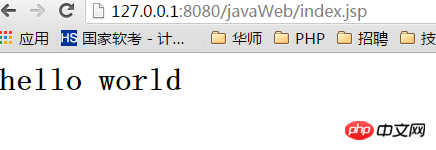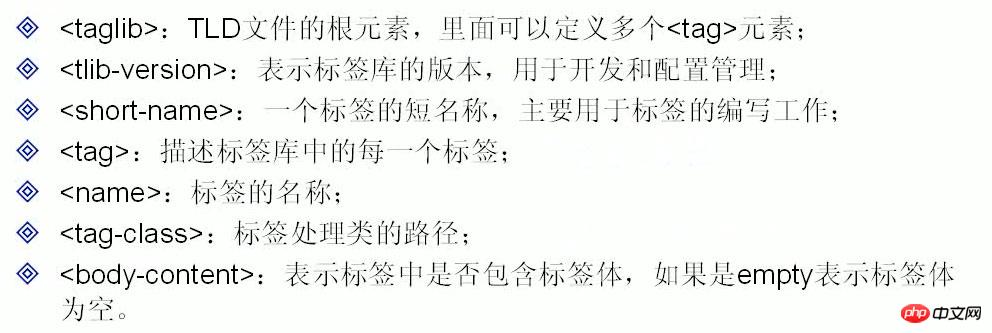Home >Java >javaTutorial >Introducing a detailed explanation of the usage of javaWeb custom tags
Introducing a detailed explanation of the usage of javaWeb custom tags
- Y2JOriginal
- 2017-05-02 13:49:061645browse
This article mainly introduces the usage of javaWeb custom tags, and analyzes the functions, definition methods and execution principles of javaweb custom tags in the form of examples. Friends in need can refer to the following
The examples in this article describe javaWeb Custom label usage. Share it with everyone for your reference, the details are as follows:
Custom tag creation
Custom tags are mainly used to remove JSP pages Java code.
To remove the java code in the jsp page, you only need to complete two steps:
-Write a Java class that inherits TagSupport, override the doStartTag method, and write the java code in the jsp page into the doStartTag method.
- Write a tag library descriptor (tld) file and describe the custom tag in the tld file.
After completing the above operations, you can import and use custom tags in JSP pages.
Tag processing class: HelloTag.java
Tag description file: hellotag.tld
jsp page call: a52e5751f07545db7efce32c1729f60aDefine emoticon
[Optional] in web. Configure hellotag.tld mapping in xml
Application process:
index.jsp ==>[web.xml]==>hellotag.tld==> ;HelloTag.java
Define the tag support class as follows:
##HelloTag.javapackage china.hubei;
import java.io.IOException;
import javax.servlet.jsp.*;
import javax.servlet.jsp.tagext.TagSupport;
//自动定义标签
public class HelloTag extends TagSupport {
public int doStartTag() throws JspException{
PageContext pg=(PageContext)super.pageContext;
JspWriter out=pg.getOut();
try{
out.println("hello world");
}catch(IOException e){
}
return TagSupport.SKIP_BODY;
}
}Tag description class, the suffix is .tld, and the content conforms to xml syntax ruleshellotag.tld<?xml version="1.0" encoding="UTF-8"?>
<taglib xmlns="http://java.sun.com/xml/ns/j2ee"
xmlns:xsi="http://www.w3.org/2001/XMLSchema-instance"
xsi:schemaLocation="http://java.sun.com/xml/ns/j2ee web-jsptaglibrary_2_0.xsd"
version="2.0">
<tlib-version>1.0</tlib-version> <!-- 标签库的版本 -->
<short-name>dqtag</short-name><!-- 标签库在TLD中的描述名称 -->
<tag>
<name>hello</name> <!-- 标签在jsp中使用名称 -->
<tag-class>china.hubei.HelloTag</tag-class><!-- 标签指向的class文件 -->
<body-content>empty</body-content><!-- 标签内容为空 -->
</tag>
</taglib>Use custom tags on jsp pages<%@ page language="java" import="java.util.*" pageEncoding="utf-8"%> <%@ page isELIgnored="false"%> <%@taglib prefix="mytag" uri="/WEB-INF/hellotag.tld" %> <!DOCTYPE HTML PUBLIC "-//W3C//DTD HTML 4.01 Transitional//EN"> <html> <head> <title>标题</title> <!-- <link rel="stylesheet" type="text/css" href="styles.css" rel="external nofollow" > --> <script language="javascript"> </script> </head> <body> <h1><mytag:hello /></h1> </body> </html>The execution effect is as follows:

<jsp-config>
<taglib>
<taglib-uri>myhello</taglib-uri>
<taglib-location>/WEB-INF/hellotag.tld</taglib-location>
</taglib>
</jsp-config>The introduction tag in index.jsp is changed to the following: <%@taglib prefix="mytag" uri="myhello" %>Remarks:

Execution principle of custom tags
When the JSP engine encounters a custom tag, it first creates an instance object of the tag processor class , and then call its methods in sequence according to the communication rules defined by the JSP specification. 1. public void setPageContext(PageContext pc). After the JSP engine instantiates the tag processor, it will call the setPageContext method to pass the pageContext object of the JSP page to the tag processor. The tag processor can later use this pageContext object. Communicate with JSP pages.2. public void setParent(Tag t). After the setPageContext method is executed, the WEB container then calls the setParent method to pass the parent tag of the current tag to the current tag processor. If the current tag has no parent tag, it is passed to setParent. The parameter value of the method is null.
3. public int doStartTag(), after calling the setPageContext method and setParent method, when the WEB container executes the start tag of the custom tag, it will call the doStartTag method of the tag processor.
4. public int doEndTag(). After the WEB container executes the tag body of the custom tag, it will then execute the end tag of the custom tag. At this time, the WEB container will call the doEndTag method of the tag processor.
5. public void release(). Usually after the WEB container executes the custom tag, the tag processor will reside in the memory and serve other requests. The web container will not call the release method until the web application is stopped.
The above is the detailed content of Introducing a detailed explanation of the usage of javaWeb custom tags. For more information, please follow other related articles on the PHP Chinese website!
Related articles
See more- How Can AtomicInteger Enhance Concurrent Programming in Java?
- How to Continuously Update a JLabel Using Swing Timer and SwingWorker?
- Why Does Java\'s Modulus Operator Yield a Negative Result for Negative Numbers?
- C# vs Java Enums: Which One Offers More Functionality?
- Can You Have Multiple Classes in a Single Java File?

